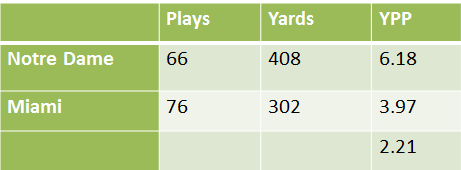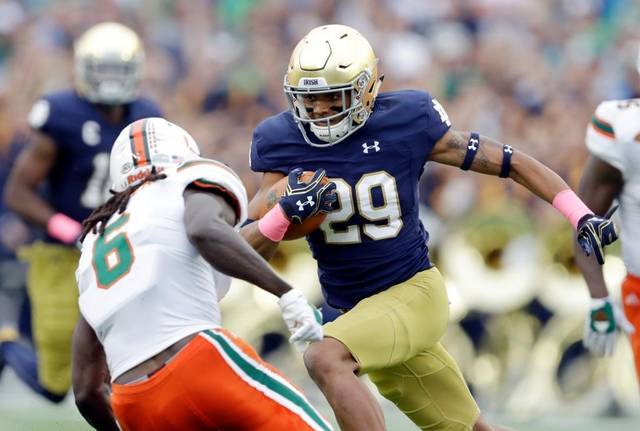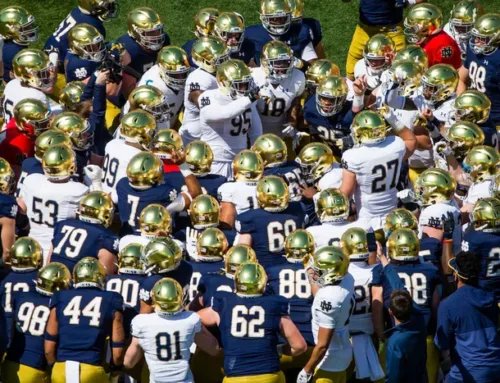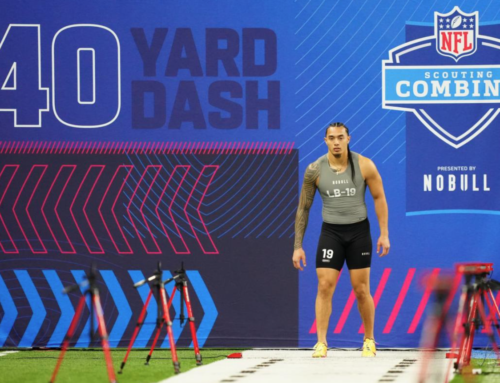The Irish outplayed Miami in the traditional phases of the game, but special teams blunders let the Hurricanes almost steal a win anyway. Breaking down an overall encouraging performance for Notre Dame with the five factors that lead to winning football games.
Confused? Check out the advanced-stats glossary here.
Explosiveness

Let’s talk about the good news first – in the “traditional” phases of the game, Notre Dame thoroughly outplayed the Hurricanes. Outgaining Miami by 2.21 YPP is significant – using a year of historical data, teams that had a margin of +2 to +3 YPP won 95% of games with an average margin of +23 points. Saturday’s game featured the lowest YPP output offensively for the Canes this season and the 2nd worst YPP allowed defensively.
So just in looking at the box score, you’d expect to see a decent cushion for the Irish. Unfortunately due to the disastrous special teams performance, that wasn’t the case. Without rehashing the gory details, the unit managed to gift Miami three offensive possessions in a row in the 2nd quarter and the go-ahead touchdown in the 4th.
Defensively, this was a performance that was the polar-opposite of a typical Brian Van Gorder era game. In four games with BVG at the helm, the defense had 17 tackles for a loss. On Saturday they had 12, with five sacks of Brad Kaaya for good measure. Jarron Jones played like man possessed against a woeful Miami offensive line. And while a lot of my predictions for this year have turned out to be unthinkably wrong, the assertion that this linebacking group would be better than last seasons’ (even with Jaylon) is at the very least a strong debate (if not correct).

Another sign that things have changed defensively has been the lack of back-breaking gains surrended by the Irish defense. The Miami offense had been explosive in both the passing and running game entering this one, and the Notre Dame defense forced sustained drives that the Hurricanes offensive line couldn’t hold together for the most part.
Across the Notre Dame internets I’ve seen a decent amount of negativity about the offense despite the win. And while the Hurricanes defense is trending downward, likely due to injuries and increased level of competition, 30 points on the 26th ranked defense in S&P+ is very solid. And those 30 points came even with a limited number of possessions thanks to the special teams blunders.
Seven of the 11 Irish possessions generated scoring opportunities (inside the Miami 40). Finishing those drives was hit and miss – settling for three field goals isn’t ideal, and the failed 4th down screen pass to CJ Sanders was nauseating. But this looked to be a bad matchup for the ND offense against a team with a very disruptive defensive line, and the Irish ran the ball for 5.74 yards per carry on Miami and gave up just one sack.
Taking out the NC State hurricane game, the Notre Dame offense is averaging 6.42 yard per play, a number that would rank 24th in FBS – just ahead of West Virginia, FSU, and Michigan. You can make the argument that the offense as a whole has disappointed given the overall level of talent, but the unit certainly isn’t average or bad as I’ve seen claimed. In the past five seasons under Brian Kelly (going from 2015 to 2011) the Irish have finished 8th, 20th, 27th, 7th, and 20th in Offensive S&P+, so while critics may argue with play-calling and scheme, the results have been pretty consistently positive.
Efficiency

The Hurricanes offensive success in 2016 has been driven more by explosiveness than efficiency, but the performance by the Irish defense in this one was still impressive. The Canes were held to just a 13.8% success rate running the ball, with the Irish defensive line collapsing holes before Miami’s speedy backs had any room to work with.
Taking out sack yardage, the Hurricanes were held to 55 yards rushing on 29 carries (1.9 YPC). The Notre Dame defense set the tone on first down, holding 13 carries to a total of 25 yards. This dominance forced one and sometimes two passing downs and allowed the Irish to thoroughly win the leverage game below.

On offense, the third down struggles for ND have been well-documented, but they came through on Saturday with a 50% conversion rate, their highest of the year. Helpful to that effort was avoiding negative plays against a Miami team that had led the nation in TFL – the average 3rd down distance to go was 5.5 yards.
Field Position
Average Starting Field Position
Notre Dame: Irish 36
Miami: Canes 28
This win is in name only, as it doesn’t take into account the CJ Sanders muffed punt turned touchdown (which I’d like to count as a drive starting in the ND endzone, but won’t for consistency with S&P+’s sake). The Irish were bolstered by the defensive performance in starting field position – Cole Luke’s interception allowed a drive to start on the Miami 13, and they added four more three and outs for good measure.
Speaking of special teams, the Justin Yoon concern-o-meter is back to reading perfect zero after a 3-for-3 performance. The punt team, however, had another really bad day – a partially blocked punt went just 23 yards, and a 52-yarder in the 4th quarter was returned 30 yards to flip the field. Notre Dame entered the game ranked 123rd in FEI’s punt efficiency, and after this performance has to be close to last in FBS (a punt blocked / returned for a TD weighs heavily here).
Finishing Drives

After a strong start to the season, the Irish are slowly backtracking in their ability to finish scoring opportunities inside the 40 and the red zone. After beginning the season in the top 10 nationally, the Notre Dame offense now ranks 48th in finishing drives, with 4.94 points per drive inside the 40. Saturday’s performance was aided by Josh Adams’ 41-yard touchdown run, which counts as a converted scoring opportunity.
Notre Dame has actually run the ball well in power run situations (80% power run success rate), which should in theory be helpful in extending these drives and converting near the goal line. But the offense has gone more pass-heavy in the red zone in recent weeks – for example, Notre Dame passed on their first seven plays in the red zone plays against Miami. Those passing plays resulted in two touchdowns but also five incompletions that led to twice settling for field goals.
Turnovers
The Notre Dame offense didn’t turn the ball over, but the punt return issues both count as fumbles and led to 14 Miami points. Cole Luke’s interception was a thing of beauty, and a sign of progress for a secondary that hasn’t been around the ball enough. The Irish had 8 pass break ups against the Hurricanes after averaging 2.7 per game through the first seven games. Over time around 20-25% of PBU’s are intercepted, so if the Notre Dame defense can continue to get their hands on more passes, the Irish might start generating more turnovers for the first time in a long time.





A If the LB’s are better this year, I think most of that falls on BVG for scheme and personnel . I would like to know what the def. coaches truly thought of his plans.
On that 4th down pass. Though I am in the RTDBK club, I think most of the blame falls on play design rather than throwing it. There was only one Miami DB on that side of the field. A quick slant to one of the WRs or send one WR deep and one short, would have gone for big yards. Instead they threw a screen, where the other WR needed to sustain a block, when he failed the play blew up.
I think the play design was ok – Hunter just needs to block the corner in any direction or cut him and it’s a TD. The execution was bad, from a high and soft pass to Hunter’s block. My assumption is that things just got thrown off on that play – it probably was a QB sneak of some variety with two WRs split out to force Miami to put two DBs out there …. and they didn’t. So Kizer had to make a crunch-time decision to stick with it with one more guy than expected in the box or audible, and we all saw how that went.
Absolutely – Jaylon playing in the DC Triumvirate (Kelly/Hudson/Elston) scheme would probably be doing amazing things right now. Well, even more amazing things. Most likely VanGorder’s defense was non-awful last year only because of what Jaylon was able to do. Nonetheless, linebacker play as a whole does seem to be steadier, particularly as Nyles Morgan has really emerged over the last few weeks.
Like Mike says, the adjustment in that case should’ve been to have one receiver go deep and one stay short. Either the corner gives up an easy first or a touchdown, with less execution needed to complete the play. Oh well.
That wasn’t Mike that said that.
Ha. Well, don’t I feel sheepish. Solid analysis, tlndma. Well done.
The problem with the “one deep, one short” criticism is that we’re calling the perfect play for the situation after the fact, when Kizer has limited options to check to in the moment. He has to react to an unexpected opportunity and get into the best play available to him to take advantage of it.
It should be set in advance – there should be some kind of call to specifically adjust to when one defender is alone against two receivers. It happens more often than you’d think, so it’s not unreasonable to have a specific check for it that’s always available.
I don’t know if the check Kizer made was a generic one that seemed to fit, or if that is our set-in-advance check for that situation. If the latter, I don’t think it’s the best way to handle it, but then I don’t get paid to do this.
On a slightly different subject, probably a totally different subject, I just heard Jac Collinsworth on Syrius XM comparing Harbaugh and BK. He talked about how significant he thought Derek Jeters tweet comparing the two coaches was, and how much impact little things like that had on recruiting.
I’m gonna put it out there right now, I’m old, I know I’m old because I couldn’t deal with recruting as it is today. These coaches spend up to (two and a half years?) kissing these kids asses to come play for them, and then as soon as they get them on campus, they switch from kissing their asses, to kicking their asses. This seems so crazy to me. No wonder these kids go into culture shock. They go from getting stroked every time they talk to a coach, to getting pounded on as soon as they start practice.
I have to figure they are placing these kids in very adversarial positions in practice. An old army adage is the more you sweat in training, the less you bleed in combat. I can’t see it being any different for college football, at any level. You have to test them when it doesn’t matter, in order to have confidence in how they’ll perform when it does matter, right?
I would have to be that guy that tells them how it is before they commit. I probably wouldn’t be very successful as a recruiter because of that.
Yep, definitely a different subject.
Quite a bit to unpack here. First off, Donovan Jeter is completely full of it. No other prospect has ever said Kelly is arrogant, and our commits and even targets were quoted in the same ESPN article as saying they have no idea what Jeter is talking about. Most likely someone at Michigan, like, say, an assistant coach who has a long history of trashing Notre Dame every chance he gets, even though he once worked there and his daughter went there for free, got in his ear and encouraged him to at the very least embellish, if not outright prevaricate.
Moving on from him, though… I think there are a couple of general approaches to recruiting. Harbaugh certainly doesn’t kiss anyone’s ass – in fact there’s a story about Dayne Crist preferring Stanford but being weirded out by Harbaugh’s intensity during the recruiting cycle. Neither does Kelly. On the other hand, some other guys, like Urban Meyer or Butch Jones, like to make lots of promises to recruits just to get them on board with no intention of ever fulfilling them. It doesn’t burn Urban because he wins like crazy, and nobody cares what a jilted kid thinks about him. It’s becoming an issue for Butch right now in Knoxville, though. So that’s a dangerous game.
I think Kelly and his staff have always told kids that it will be tough physically and intellectually at Notre Dame, but it will be rewarding. To Harbaugh’s credit, I think he did the same at Stanford and is at Michigan right now, even if his delivery is a little, you know, insane. Anyway, there are plenty of kids who will be attracted by the realistic pitch. And you wouldn’t want the kids who would be turned off by it, IMO.
I’m pretty sure Saban falls under the category of “telling it like it is”. This is from his recruitment of Julio Jones.
Way to bury the lede–Jac Collinsworth has a show on XM radio? Holy crap we knew that kid would hit it big in media, but he’s already got a show? Awesome. I still think he could sub in for his dad on Sunday night football, and until they showed him on camera, no one would know the difference.
As for the rest, there’s a reason “de-recruiting” is a phrase used by coaches. They have to undo the work done on kids during the recruiting cycle, essentially de-programming them. Crazy.
No kid, with any interest, is going to bother with Jeter’s tweet. (Derek or Donovan)
I definitely can see coaches stroking kids egos. I guess my point was more to the dynamics of going from stroking egos to you have flaws, and we need to fix them. I can’t think of a team sport, where the winning team members didn’t stress the importance of their relationships with teammates and coaches, and how important that was to overall success. I know from personal experience that the relationships I shared with my teammates were extremely important to me. I would feel sleazy going from your the greatest, to you suck, and you need a lot of work.